Seasons of Change
For over 330 articles, MUSUBI has been your bridge to inner Japan. As March becomes April, change is in the air. Not just in the literal environment, but in the metaphorical one as well. A new school year is around the corner. A new fiscal year for businesses begins. Old friends depart, and new ones arrive.
MUSUBI has been a part of my life for over 3 years now, and it’s about to undergo its own change. In the coming weeks, updates will be a little sporadic as the blog emerges in a newer, better form. The transformation begins soon, and we hope to see its completion this year.
From all of us here at the MUSUBI staff: stay tuned- the fun is just getting started!
Top Photo: himawariin on PhotoAC
Welcome once again to the Best of MUSUBI, where the past becomes the present, much like the old stuff you would find in a recycle shop!
The value and quality of Japan’s second-hand stores is one of their best-kept secrets, and one that is quickly discovered by new ex-patriots to the country. Due to the overall good quality of Japanese products combined with the Japanese people’s propensity to take good care of their things, buying goods second-hand is seen as a preferred alternative by many to buying products brand new. You will almost always find some incredible deals and rare finds in any second-hand stores if you take the time to look for them.
Here’s a basic guide of what you’ll be getting into at a Japanese リサイクルショップ (recycle shops) and the names of a few popular chains. Nothing beats the feeling of adding to your wardrobe or picking up furniture for a fraction of the price!
Things to know in advance
As far as what is available at second-hand stores in Japan, you’re not going to find much difference between them and any other stores from other countries. Clothes, toys, collectables, bags, accessories, appliances, furniture; they sell everything. The differences on what shops will sell is often based on location.
Stores that are in more urban areas will usually focus on selling clothes due to lack of space, whereas shops in the suburbs will have plenty of furniture and bigger appliances for sale. Also, even chain second-hand stores will sometimes focus on selling genres of goods at a store location, such as electronics and toys, rather than have an eclectic mix that second-hand stores are known for. In many cases, this makes for more focused shopping.
Another thing that is worth mentioning is the quantity of quality name-brand goods you are going to see at these stores, especially in the more central locations of larger cities like Tokyo and Osaka. It is not unusual for the bigger shops in downtown areas to have multiple items from companies such as Gucci, Prada, Armani, Coach, and so on.
Quite possibly one of the greatest things about Japanese recycle shops is that they offer automatic warranties on the appliances they sell. Seriously! Now bear in mind that these warranties are usually three to six months long, but still, it’s definitely reassuring to know that you aren’t out a cool ¥30,000 after buying a refrigerator that breaks two weeks after you got it. Be advised though, the especially cheap ジャンク (junk) items will not be insured, and they are buy-at-your-own-risk (as they tend to be sold mainly for replacement parts).
Finally, and what some would say is most importantly, you don’t have to be concerned about transportation when buying furniture and large appliances. Every store that I have been to that sells large items offers either free delivery or free rental of small truck (which they will load for you) in order to transport you purchases.
Now that we’ve talked about what’s available at the stores, I’m going to list some of the most popular chains in Japan.
2nd Street
With over 650 locations around the country, 2nd Street is undoubtedly Japan’s most popular second-hand store. Because they are such a massive chain and are usually located in urban centers, 2nd Street tends to divide up the products that they sell based on category and sells them at different locations. Clothes, footwear, accessories, and bags will be found at one store, while books and electronics will be found at another. I have seen very few 2nd Streets that sell furniture, but they do exist.
Hard/Hobby/Book/Garage-Off & Off-Home
I know what you’re thinking: what a name! The “Off” chain of stores correlate to what they sell. Hard-Off sells “hardware”, like electronics and musical instruments. Hobby-Off sells toys and collectables. Book-Off sells, you guessed it, books. Garage-Off sells large appliances that you would typically find in a garage, and Off-Home sells clothes and home appliances. Multiple “Off” types are often mixed with each other at single locations.
Treasure Factory
Treasure Factories probably resemble the second-hand shops in your home country more than any other chain listed here. They sell everything; from clothes to sofas, and its often all mixed together. They also offer free rental of a small truck for transportation of your goods with every purchase over ¥5,000!
One final word about second-hand shops: they are a great way to get rid of your own old stuff as long as its still in reasonable condition (i.e. if it’s still good enough that you yourself would buy it discounted.) If say you have old clothes you’re looking to get rid of that are still in decent shape, it’s possible to sell them at a recycle shop. They aren’t going to buy socks and underwear obviously, but everything from a good-quality printed T-shirt and up is generally OK. The same holds true for books/manga, furniture, electronics, collectibles, and so on.
Don’t expect to make a fortune off your old stuff, but if you bring enough, it is possible to walk away with a couple thousand or even ten-thousand yen bills depending on the item. This is a great way to speed up your moving or Sayonara Sales, and it’s a fairly smooth process. We’ll tell you all about the ins and outs of 買取 (buy-back) on MUSUBI in 2024.
Now get out there and shop!
Photo Credits:
Top Photo: himawariin on PhotoAC
All other content (text) created by the original author and © 2024 MUSUBI by Borderlink
Top Photo: uopicture on PhotoAC
Are you new to Japan (or soon to come to Japan) and confused about how the health insurance works? If so, you are not alone. With different countries having vastly different health insurance systems, it can be a little intimidating coming to terms with a new health insurance system in a foreign country – especially if you don’t speak the language. Therefore, this article aims to give an overview of what Japanese health insurance involves, how to use it, what it covers, and how to pay for it.
There are two main types of health insurance in Japan – National Health Insurance and Social Health Insurance. Which one you need to enrol in will depend on your employment situation – therefore, your employer should be able to advise you which health insurance system to enrol in and may also help with the enrolment process itself (once again, this will depend on your situation).
If you are unemployed (e.g. as a student), you will need to enrol in the National Health Insurance (this can be done when you register at the city office). Also, take care when starting a new job/leaving a job to note whether your health insurance plan will stay the same or need to be changed – if you are changing your health insurance plan, you will need to cancel the original plan in order to avoid paying for both simultaneously.
So, how much of the cost does the health insurance in Japan cover? You may be surprised to hear that medical services compatible with health insurance are covered by 70%. This means the out-of-pocket expense for you is only 30% of the original price! In order to receive this reduced price, you only need to show your health insurance card to reception when you arrive at the medical facility. The health insurance card is a must to receive the discounted price, so be sure to carry it with you when receiving medical attention. The health insurance card may be given to you at the city office when you enrol or may arrive a short while later by post.
Now that we’ve discussed how to use the health insurance card, you may be wondering which medical services are eligible to be covered by health insurance. It may be necessary to check in advance for some specific situations; however, health insurance can generally be used if you are feeling unwell or exhibiting symptoms of some kind of physical problem or issue.
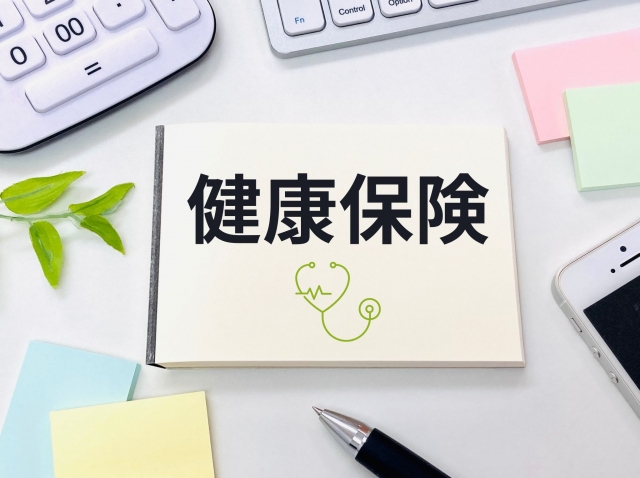
Routine checkups – such as the annual health checkups required by most full-time employers – are usually not covered by health insurance (although many employers do provide reimbursement). In addition to this, medical services classified as self-improvement, etc. (e.g. beauty treatments) generally do not qualify for health insurance coverage. As always, it is best to check in advance whether or not health insurance will be accepted.
Lastly, it is important to note that health insurance is not free. It is also worth noting that enrolment in one health insurance plan is mandatory – you do not have the option to decide for yourself whether or not you want to be covered. The amount you need to contribute each month will depend on your financial situation – typically, the more you earn, the more you need to contribute.
If you are employed full time, more likely than not your employer will automatically deduct the fee from your salary. If you are not employed full time, you will most likely need to pay for it directly using the bills you receive in the mail. These bills can be paid at a variety of locations, such as convenience stores, local banks, etc.
I hope this article answered all of your questions about health insurance in Japan! Now that you know what the health insurance involves, what it covers, how to use it, and how to pay for it, you should be able to confidently understand how to receive discounted medical services in Japan. Receiving medical care in a foreign country can be daunting, but I hope this article has allowed you to feel more confident about the financial aspects of using medical services in Japan.
Photo Credits:
Top Photo: uopicture on PhotoAC
Additional photo by craftbeermania
All other content (text) created by the original author and © 2024 MUSUBI by Borderlink
Top Photo: spaceman on PhotoAC
When you picture domestic life in Japan, you may draw to mind images of an urban landscape, a tiny apartment, and a shopping mall around every corner. And for most Japanese people, this is true; most people in Japan live in cities, and 25% of the country’s entire population lives in just the Tokyo metro area! But of course, there is a world outside of the major urban centers. It is a world of sprawling farmland, picturesque mountain vistas, and little suburban communities nestled between hills and valleys.
I live in one such town, on the outskirts of Fukuoka. I’ve spent nearly my entire life in this kind of environment; except for a brief few years living in a city in South Korea, I’ve always lived in a suburban or rural area. So, there are some things about the suburbs here in Japan that I recognize. In fact, there are a lot of houses here that are built using an American architectural style that makes me feel like I never left the states. But Japanese suburbs have a special character that I never experienced in America, which makes it impossible to mistake the whole neighborhood as anything but distinctly Japanese.
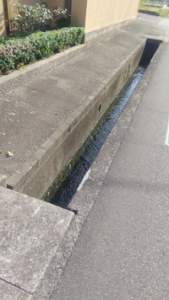 The first thing I noticed when I moved to Japan is how deep the gutters are. In the United States, street-side ditches in the suburbs are rarely more than a few inches deep, and they flow into storm drains that connect to underground tunnels for carrying away rainwater. You can easily step into an American gutter without worry, and I never even thought about tripping on one. So imagine my shock when I saw the three-foot deep gutters in my Japanese neighborhood! (That’s nearly a meter deep for you metric folks.)
The first thing I noticed when I moved to Japan is how deep the gutters are. In the United States, street-side ditches in the suburbs are rarely more than a few inches deep, and they flow into storm drains that connect to underground tunnels for carrying away rainwater. You can easily step into an American gutter without worry, and I never even thought about tripping on one. So imagine my shock when I saw the three-foot deep gutters in my Japanese neighborhood! (That’s nearly a meter deep for you metric folks.)
It may seem excessive, but Japan definitely needs these deep gutters. In the summer, there is torrential rain that floods everything, and the gutters fill to the top, overflowing with muddy water and moss. Even in the much drier winter season, I can still see water flowing at the bottom of the gutter nearly every day. In fact, the gutter water seems to be such a consistent environment that it even has fish living in it! I have often seen groups of young children dipping nets into the gutters to catch fish.
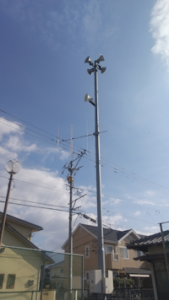 Perhaps the most surprising component of my Japanese neighborhood is the loudspeaker system. Just a few steps away from my building there is a tall pole, at the top of which are several loudspeakers which occasionally broadcast messages. It seems ominous, like something out of a dystopian story: a sterile, authoritative voice echoing through the city, forcibly seizing your immediate attention for a government message. I can’t understand the messages, but I was told by a coworker that they are reminders about emergency preparation and potential natural disasters; not quite so sinister as I first thought! These loudspeakers are everywhere in Japan, and if you understand what they’re saying, it might make life a bit easier and safer.
Perhaps the most surprising component of my Japanese neighborhood is the loudspeaker system. Just a few steps away from my building there is a tall pole, at the top of which are several loudspeakers which occasionally broadcast messages. It seems ominous, like something out of a dystopian story: a sterile, authoritative voice echoing through the city, forcibly seizing your immediate attention for a government message. I can’t understand the messages, but I was told by a coworker that they are reminders about emergency preparation and potential natural disasters; not quite so sinister as I first thought! These loudspeakers are everywhere in Japan, and if you understand what they’re saying, it might make life a bit easier and safer.
But there is one message the speaker system broadcasts that can be universally understood: music. Every day at 5pm (or 6pm during the summer) the speakers will play a song, reminding you that the day is nearly over. A coworker told me that the music is often used as a signal of curfew for young children, and their parents will expect them to come home soon after the music plays. I’ve found these musical chimes to be helpful, especially on the weekends, to motivate me not to waste the final hours of the day, so that I can finish important tasks before going to bed.
Life in the suburbs of Japan offers so much more than I can say in such a short article. Everything feels so close, from the friendly people to the walkable shops and restaurants, and I’ve never lived in such a safe and nicely maintained environment. Some of the stranger quirks were difficult to get used to; even after living here for nine months I’m still a little anxious about falling into the gutter! But in nearly every way, my life in Japan has been pleasant, and I love where I live.
Photo Credits:
Top Photo: spaceman on PhotoAC
Additional photos were provided by Justin U., used with permission.
All other content (text) created by the original author and © 2024 MUSUBI by Borderlink
Burgers. You can get one anywhere right? Well, I haven’t eaten anything from McDonald’s or similar fast food restaurants for 16 years. That being said, I’m on an ongoing quest to eat the best burgers Tokyo has to offer. If you’re like me and you can appreciate a quality burger, you’ll definitely have to stop for lunch at each of these fine burger establishments. Here are the best burgers I’ve had in Tokyo… so far.
Sunny Diner
 Sunny Diner is a small and cozy restaurant. Its décor is very much inspired by 1950’s diners in America. You’ll be thinking it’s the kind of place you’ve seen in the movies. I had a bacon cheeseburger with onion rings. It came with all the vegetables on the side. Some of you might really like that (it keeps them particularly cool and fresh); I piled them right onto my burger. The burger was big & juicy, and had a nice soft bun. When I went there I saw a long line of women waiting for the place to open. In fact, most of the burger shops I went to seem to have far more women eating there than men. One thing I should warn you about: the drinks are absolutely enormous. Well, it may not be a ‘warning’ if you’re visiting in the summertime!
Sunny Diner is a small and cozy restaurant. Its décor is very much inspired by 1950’s diners in America. You’ll be thinking it’s the kind of place you’ve seen in the movies. I had a bacon cheeseburger with onion rings. It came with all the vegetables on the side. Some of you might really like that (it keeps them particularly cool and fresh); I piled them right onto my burger. The burger was big & juicy, and had a nice soft bun. When I went there I saw a long line of women waiting for the place to open. In fact, most of the burger shops I went to seem to have far more women eating there than men. One thing I should warn you about: the drinks are absolutely enormous. Well, it may not be a ‘warning’ if you’re visiting in the summertime!
Sunny Diner, 3-45 Senju, Adachi City, Tokyo 〒1120-0034
Burger Mania
Burger Mania also has an ‘old American’ style to it. The dining room was very big and just full of patrons chowing down on huge hamburgers. When you see the classic and cozy atmosphere, you’ll know they put real effort into the design. While you’re eating here, you’ll get the feeling that you are far away from Tokyo.
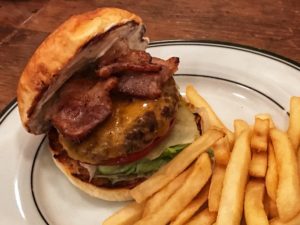 The staff asked if we wanted to sit in the front of the shop, near the open windows or the back of the shop. I chose the back, because I was worried about the street noise. It was a mistake though because of how loud the music was blaring back there. It was so loud it was difficult to have any conversation. The staff were very kind and attentive from start to finish though. Maybe I should have asked if they could turn down the music. That being said, I did enjoy the tunes they were playing.
The staff asked if we wanted to sit in the front of the shop, near the open windows or the back of the shop. I chose the back, because I was worried about the street noise. It was a mistake though because of how loud the music was blaring back there. It was so loud it was difficult to have any conversation. The staff were very kind and attentive from start to finish though. Maybe I should have asked if they could turn down the music. That being said, I did enjoy the tunes they were playing.
At Burger Mania I had a bacon cheese burger with a side of French fries. It had the softest, freshest-tasting bun ever, slathered with delicious sauce. They say everything is handmade as much as possible there; I’m prepared to believe they really do make those amazing hamburger buns in house. They also have many unusual menu items and monthly specials, so you have plenty of good reasons to come back here again and again.
Burger Mania, 4 Chome-9-5 Ebisu, Shibuya City, Tokyo 〒150-0013
Cafe NEWOLD
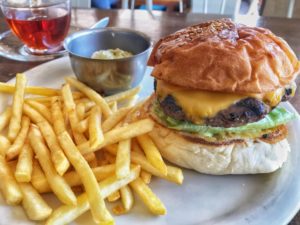 Cafe NEWOLD’s dining room is very cozy. It’s rustic, wooden & minimal. It could use a bit of a sweep, dusting and light tidying up, but I was very comfortable there. What I really liked was they had a video projector that was playing classic Tom & Jerry cartoons on a cement wall. They had it on both times I visited. You can see right into the kitchen, so it’s clear to see the cooks are not just heating up fast food. The grill can make the place a little smoky, but it adds to the charm and it didn’t bother me at all.
Cafe NEWOLD’s dining room is very cozy. It’s rustic, wooden & minimal. It could use a bit of a sweep, dusting and light tidying up, but I was very comfortable there. What I really liked was they had a video projector that was playing classic Tom & Jerry cartoons on a cement wall. They had it on both times I visited. You can see right into the kitchen, so it’s clear to see the cooks are not just heating up fast food. The grill can make the place a little smoky, but it adds to the charm and it didn’t bother me at all.
Cafe NEWOLD serves what is quite possibly the best hamburger you can eat in Tokyo. I had a cheeseburger lunch set that came with Fench fries, coleslaw and tea. The burger was just cooked to perfection and the coleslaw was really good too. There is no way you will be disappointed with this place, unless you try to eat there on a Monday: that being, it’s closed on Mondays (so as to stay open on weekends, many smaller Japanese shops may pick a random weekday to be closed).
Cafe NEWOLD, 3 Chome-9-11 Tsurumaki, Setagaya City, Tokyo 〒154-0016
The Burger Craft
 At The Burger Craft I had a cheeseburger with a side of thick potato wedge French fries. It had a lot of delicious sauce. It was a ¼ pound 100% beef patty. The meat was juicy and it had a tasty and very chewy bun that absorbed the meat juices and it became even yummier. At this place, cheeseburgers are their standard. Basically everything on the menu has cheese on it.
At The Burger Craft I had a cheeseburger with a side of thick potato wedge French fries. It had a lot of delicious sauce. It was a ¼ pound 100% beef patty. The meat was juicy and it had a tasty and very chewy bun that absorbed the meat juices and it became even yummier. At this place, cheeseburgers are their standard. Basically everything on the menu has cheese on it.
They use ½ Japanese beef and ½ Australian beef. There is only 1 chef who cooks the burgers, so if it’s really busy, it can take a little time. Also, their sauce is handmade.
The shop is very small. It’s minimal & clean, with a lot of wood textures. Definitely the smallest dining room of them all. A little bit more expensive, but I think you’ll forget all about that when you have a mouth full of their delicious burgers. This shop requires a drink order if you are dining in. If it’s a nice day out the next time I stop by, I’ll probably take it to go and eat it in a nearby park.
The Burger Craft, 3 Chome−17−3 1F, Asakusa, Taito City, Tokyo 〒111-0032
If you have a little more time & money, can appreciate an interesting and relaxing atmosphere and have an appetite for a unique take on something familiar, you should definitely make your way to each of these burger shops. And keep an eye out for new ones- you just may find one to add to the list!
Photo Credits:
Additional photos were provided by Raymond D, used with permission.
All other content (text) created by the original author and © 2024 MUSUBI by Borderlink
